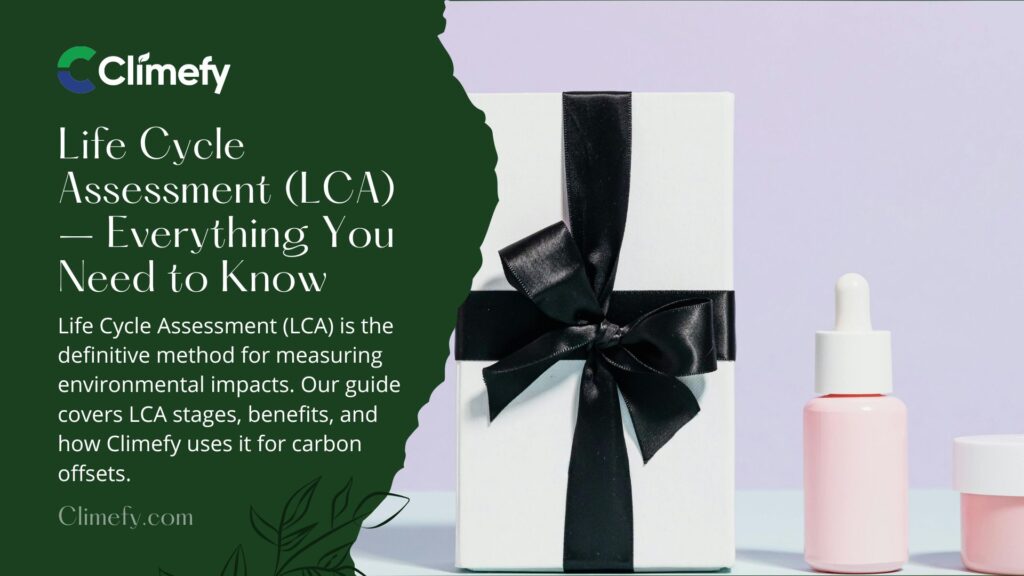

Life Cycle Assessment (LCA) is a comprehensive, standardized methodology for evaluating the potential environmental impacts associated with a product, process, or service throughout its entire life cycle. From raw material extraction (cradle) to manufacturing, distribution, use, and final disposal (grave), an LCA provides a holistic view, enabling businesses, policymakers, and individuals to make truly informed, data-driven decisions for sustainability. This powerful tool moves beyond simplistic claims, quantifying impacts across multiple categories to prevent problem-shifting and guide meaningful environmental progress.
In this definitive guide, you will learn:
Read More:

A Life Cycle Assessment (LCA), also known as life cycle analysis, cradle-to-grave analysis, or ecobalance, is a systematic, science-based process for quantifying the environmental burdens linked to a product or service.
The core strength of LCA lies in its holistic, systems-thinking approach. Instead of focusing on a single manufacturing stage or a single type of emission, it compiles an inventory of relevant energy and material inputs and environmental releases.
It then evaluates the potential impacts associated with these inputs and releases, ultimately interpreting the results to help make more sustainable choices. This methodology is internationally standardized under the ISO 14040 and 14044 standards, ensuring consistency, reliability, and credibility across studies.
In an era of increasing greenwashing concerns, LCA provides the rigorous, verifiable data needed to back up environmental claims and build trust with consumers and stakeholders.
The criticality of Life Cycle Assessment stems from its ability to reveal hidden impacts and avoid problem-shifting. For instance, a company might switch to a lighter packaging material to reduce transportation emissions (a valid goal).
However, without an LCA, they might miss that the production of that new material requires extremely energy-intensive processes or is non-recyclable, thereby shifting the environmental burden from the use phase to the manufacturing and disposal phases. LCA prevents this by considering the entire system, ensuring that solutions are genuinely sustainable and not just superficially green.
✅ Established Facts about LCA:
The LCA framework, as defined by ISO standards, is structured into four interrelated phases. This structured approach ensures the study is comprehensive, methodologically sound, and transparent. Understanding these phases is essential for anyone looking to commission, interpret, or rely on an LCA study.
This is the critical planning phase where the foundation of the entire LCA study is laid. It defines the purpose, boundaries, and depth of the study. A clearly defined goal and scope prevent ambiguity and ensure the final results are fit for their intended purpose.
The Life Cycle Inventory (LCI) phase is the data collection heart of the LCA. It involves creating a detailed inventory of all the inputs and outputs for every process within the defined system boundaries. Inputs include water, energy, raw materials, and chemicals. Outputs include the desired product, air emissions, water emissions, solid waste, and co-products.
This phase is highly data-intensive. Data can be:
All this data is linked together based on the flow of materials and energy, creating a comprehensive model of the product system. The output of this phase is a massive table quantifying all inputs and outputs relative to the functional unit.
The Life Cycle Impact Assessment (LCIA) phase is where the inventory data is translated into potential environmental impacts. It takes the long list of emissions and resource consumptions from the LCI and converts them into a manageable number of environmental impact scores that are easier to understand and interpret.
The LCIA process involves several steps:
Common LCIA impact categories include:
This is the final phase where the results from the LCI and LCIA are combined and analyzed to draw conclusions, explain limitations, and provide recommendations. The aim is to provide a clear, understandable, and robust basis for decision-making.
Key activities in this phase include:
Not all LCA studies are the same; they are tailored to different goals and stages of a product’s development. Understanding the types of LCA is crucial for selecting the right approach.
This is the most comprehensive LCA type, encompassing the entire life cycle of a product from raw material extraction (cradle) through manufacturing, transportation, and use, to its ultimate disposal or recycling (grave). It provides the full picture of a product’s environmental footprint and is often used for holistic environmental product declarations (EPDs) and strategic planning.
This assessment covers the journey from raw material extraction (cradle) up to the factory gate, just before the product is transported to the consumer. It includes all the upstream supply chain and manufacturing impacts but excludes distribution, use, and end-of-life phases. Cradle-to-gate assessments are commonly used for business-to-business (B2B) communication, such as Environmental Product Declarations (EPDs) for intermediate products or raw materials.
This is a partial LCA looking at a single value-added process or a specific set of processes within a larger production chain. For example, a company might conduct a gate-to-gate LCA to analyze the environmental impact of a specific manufacturing step within its plant to identify efficiency improvements. These studies are useful for internal process optimization but cannot be used to make claims about the entire product.
This is a conceptual framework rather than a strict ISO-standardized LCA type. It models a circular economy system where the “end-of-life” stage is redesigned to be a “renewal” stage. Materials are designed to be continuously cycled back into the production system, either as biological nutrients that safely biodegrade or as technical nutrients that are continually reused without loss of quality. While an LCA can be used to assess a cradle-to-cradle designed product, the concept itself goes beyond traditional LCA by emphasizing material health and reutilization.
A robust Life Cycle Assessment evaluates impacts across multiple categories to provide a multi-dimensional perspective and avoid burden shifting. Here are the key impact categories typically included:
Life Cycle Assessment has moved from a niche academic exercise to a core strategic tool for leading businesses and governments. Its applications are vast and directly tied to competitiveness and regulatory compliance.
LCA provides quantitative data to guide designers and engineers in creating more sustainable products. By identifying environmental hotspots early in the design process, companies can make informed choices about materials, manufacturing processes, and product longevity, ultimately reducing costs and environmental impact simultaneously.
For most complex products, the vast majority of the environmental footprint lies in the supply chain (Scope 3 emissions). LCA enables companies to map their supply chain impacts, identify high-impact suppliers, and make more sustainable procurement decisions. This is essential for robust corporate carbon accounting and achieving science-based targets.
LCA data is fundamental for credible Environmental, Social, and Governance (ESG) reporting and sustainability reporting. It provides the scientific backbone for claims about a product’s environmental performance. Furthermore, LCA is indispensable for developing a credible Net Zero Journey, as it helps a company understand its full carbon footprint (Scopes 1, 2, and 3) and identify the most effective reduction strategies. Companies like Climefy offer ESG Consultancy that leverages LCA principles to build comprehensive sustainability strategies and transparent reporting frameworks for businesses.
LCA is the basis for many environmental labels and declarations, such as Type III Environmental Product Declarations (EPDs), which are standardized documents that transparently communicate the life cycle environmental impact of a product. This helps combat greenwashing and allows environmentally conscious consumers and business purchasers to make informed comparisons.
Governments use LCA to develop effective environmental policies, such as extended producer responsibility (EPR) schemes, green public procurement (GPP) criteria, eco-labeling programs, and carbon tax frameworks. LCA helps ensure that policies are based on robust science and actually lead to overall environmental benefits.
Despite its power, LCA is not without its challenges. Acknowledging these limitations is key to properly interpreting and using LCA results.
Carbon footprinting is essentially a simplified, single-issue LCA that focuses exclusively on the Global Warming Potential (GWP) impact category. It is a subset of a full LCA. Calculating a corporate or product carbon footprint follows the same LCA principles: defining the goal and scope (e.g., organizational vs. product footprint, Scopes 1, 2, and 3), compiling an inventory of greenhouse gas emissions, and characterizing them into a single CO2e metric.
This is where the synergy with carbon offsetting becomes clear. Once an organization has used LCA principles to measure its carbon footprint, it can then develop a strategy to reduce it. For emissions that are currently unavoidable, high-quality carbon offsets can be used to balance out the impact. This is a core part of the transition to net-zero.
Climefy operates at this critical junction. By using tools like the Carbon Calculator for Large Organizations, businesses can get a detailed understanding of their emissions profile. To address their unavoidable emissions, they can turn to the Climefy Marketplace, which offers a portfolio of verified GHG reduction projects, including Afforestation and Plantation and Solid Waste Management initiatives.
These projects are rigorously assessed using methodologies that share principles with LCA to ensure their environmental integrity and additionality. Furthermore, the Climefy Verified Carbon Standard provides the robust framework needed to ensure every carbon credit represents a real, measurable, and permanent tonne of CO2e reduced or removed, bringing credibility and impact to corporate climate action.
The field of LCA is continuously evolving to address its limitations and meet new challenges. Key future trends include:
A carbon footprint is a subset of an LCA. An LCA assesses multiple environmental impacts (e.g., water use, toxicity, resource depletion), while a carbon footprint focuses solely on greenhouse gas emissions and their contribution to climate change (Global Warming Potential).
The cost of an LCA can vary dramatically, from a few thousand dollars for a simplified screening LCA using generic data to over $50,000 for a comprehensive, ISO-compliant study of a complex product requiring extensive primary data collection. The cost depends on the product complexity, data availability, and the study’s goal and scope.
Several dedicated LCA software packages are available, such as SimaPro, GaBi, OpenLCA, and One Click LCA. These tools contain extensive life cycle inventory databases and provide the modeling environment to build and analyze product systems.
While a full LCA is not universally mandatory, aspects of it are becoming increasingly regulated. For example, the European Union’s Corporate Sustainability Reporting Directive (CSRD) requires large companies to report on their environmental impacts, including Scope 3 emissions, which inherently requires a life cycle thinking approach. Specific product categories may also require EPDs in certain markets.
A screening LCA can take a few weeks, while a detailed, ISO-compliant LCA for a complex product can take several months to over a year, depending on data collection challenges and the depth of the analysis.
LCA can absolutely be applied to services. The methodology is the same; the “product system” is defined as the service delivery. For example, an LCA of a cloud data storage service would assess the impacts of the data centers, network infrastructure, and end-user devices over a defined functional unit, such as “providing 1 terabyte-month of data storage.”